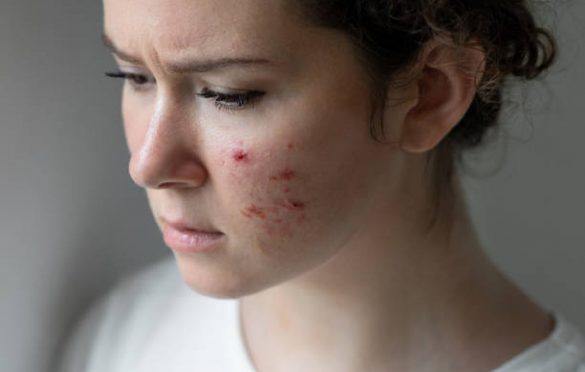4 Causes of Red or Flushed Skin

Blushing and flushing are common skin reactions that many people experience periodically, and are a minor nuisance to some. In most cases, it is a harmless and temporary condition caused by high heat exposure, intense exercise, or certain emotional reactions such as embarrassment or excitement.
When it occurs frequently or excessively, it can be an indication of something more serious, such as an underlying medical or health condition. Identifying the cause of redness and flushed skin is the first step toward improving and resolving the condition.
Sometimes people can start to experience more than normal blushing as they get older, and struggle with it without realizing it is a treatable condition or there is an avoidable cause. Substance use disorders such as alcoholism and heroin addiction can affect blood circulation and internal body temperature regulation, causing abnormal skin reactions and discoloration.
The following are four of the most probable causes of red or flushed skin that flares up more severely and frequently than what is considered normal.
Table of Contents
1.Reactions to Medications
Prescription and over-the-counter medications can cause a variety of unexpected and undesirable side effects. Skin is sensitive to internal changes, and flushing may be the body’s allergic reaction to a foreign substance or caused by adverse interactions with other medications.
Skin inflammation and drug rashes can be an adverse side effect of a new medication or drug that may subside as tolerance builds. If the redness persists and worsens, this could be caused by a severe allergic reaction to the medication.
Medications that can cause skin flare-ups and redness include:
- antibiotics
- nitrates
- opioids, such as morphine
- calcium-channel blockers
- steroids
- barbiturates
- anticoagulants
- diuretics
- nicotinic acid
Excessive alcohol use and abuse of certain drugs, such as heroin and other opioids, are frequent factors of drug rashes and skin changes. This can be caused by an allergic reaction, and other various health complications caused by drug toxicity.
2. Skin Conditions
Skin conditions that result in redness and irritation affect many people, especially those with sensitive skin and fair complexions. Symptoms may flare up later on in adulthood due to hormonal changes or certain triggers that activate the condition.
Besides facial flushing, other symptoms of rosacea include:
- acne and swollen, pus-filled bumps
- visible, dilated veins
- dry, irritated, and swollen eyelids
- burning, tender skin
- enlarged, swollen nose
Rosacea is a common skin condition that causes irritation and redness of facial skins and can worsen the longer it persists untreated. Alcoholism is frequently associated with rosacea, and although it is not a direct cause, alcohol is one of the common triggers of rosacea flare-ups.
Other rosacea triggers can be the following:
- hot beverages
- spicy foods
- irritants in topical products
- sunlight
- extreme temperatures
- emotional stress
3.Hormonal Imbalances
Fluctuations and imbalances in hormone levels can affect sensitive skin, causing chronic irritation and redness. Women who are vulnerable to skin conditions may experience flare-ups during menstrual cycles or menopause when their reproductive hormone levels go through sudden changes.
Hormonal imbalances can trigger spikes in body temperature and hot flashes, causing inflammation and flushing of the face. Hormonal disorders can also cause redness and irritated skin, and may require diagnosis and treatment.
The endocrine system contains glands that produce essential hormones and control bodily functions such as reproductive function, metabolism, bone and tissue growth, cardiac health, and thyroid function. An endocrine disorder or disease is caused by hormonal balances that disrupt these functions, resulting in a variety of medical conditions including skin changes and sensitivities.
Some of the most common endocrine disorders include:
- Diabetes
- Adrenal insufficiency
- Cushing’s disease
- Gigantism (growth hormone disorder)
- Hyperthyroidism
- Hypothyroidism
- Hypopituitarism
- Polycystic ovarian disorder
- Precocious puberty (abnormally early puberty)
- Premature menopause or ovarian failure
4.Autoimmune Disorders
Autoimmune conditions commonly trigger inflammation of skin cells, causing irritated, red skins and rashes, especially on parts of the body that get more sun exposure. Sun sensitivity is a side effect of autoimmune diseases and disorders that often activates latent skin conditions and exacerbates symptoms, or causes conditions to develop.
Autoimmune conditions that cause skin irritation and rashes include:
- Lupus
- Celiac disease
- Eczema
- Dermatomyositis
- Psoriasis
- Sjogren’s Syndrome
- Scleroderma
Inflammation of the skins caused by autoimmune conditions may be treated with prescription and over-the-counter medications to manage flare-ups and reduce the severity of symptoms. However, some medications can cause more severe skin reactions, so consulting with a physician or dermatologist beforehand is a preventative measure against adverse side effects of pharmacological treatments.


